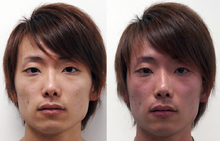Alcohol intolerance
| Alcohol intolerance | |
|---|---|
| Other names | Acute alcohol sensitivity |
 | |
| Skin flushing, a common symptom of alcohol intolerance | |
Alcohol intolerance is due to a
Drinking alcohol in addition to consuming calcium cyanamide can cause permanent or long-lasting intolerance (nitrolime disease),[11][12] contributing (in conjunction with other substances) to the accumulation of harmful acetaldehyde in the body by inhibiting the acetaldehyde dehydrogenase enzyme.
Signs and symptoms
Individuals with alcohol intolerance will experience unpleasant reactions immediately after drinking alcohol.
Causes
Genetics

ALDH1 is an isozyme of aldehyde dehydrogenase. A structural mutation in the gene of ALDH1, commonly found in East Asians, results in low levels of functional ALDH1 enzyme and thus, higher blood acetaldehyde levels.[14][1][2] Higher blood acetaldehyde levels have been associated with facial flushing caused by an increase in heart rate and blood flow to the face from vasodilation of the blood vessels.[1][2] Individuals that have the ALDH2*2 allele, a variant that has a mutation when compared to the wild-type ALDH2 isozyme, are known to have higher blood acetaldehyde levels.[15][16][2] Individuals that have either mutation in the ALDH1 or ALDH2 genes may have slightly different blood acetaldehyde levels among others carrying a similar mutation and may experience varying degrees of alcohol intolerance symptoms.[17][18][19]
Risk factors
Various genetic and environmental factors exist that can lead to an increased risk for developing alcohol intolerance. Individuals with two copies of the ALDH2*2 allele are known to have high blood acetaldehyde levels and experience “hangover” symptoms such as heart palpitations for longer durations, even with low alcohol consumption.[15][16][2] Individuals who work with DMF have shown a dose-related increase in alcohol intolerance complaints.[20] Exposure to DMF can also cause facial flushing and increased sensitivity to alcohol.[21][22]
Diagnosis
Ethanol patch test
In an ethanol patch test, different concentrations of ethanol are applied onto lint pads and attached to the inner surface of the upper arm for several minutes. If skin redness occurs after 10–15 minutes, the individual is deemed to have a lack of ALDH1 associated with alcohol intolerance.[23]
Difference from alcohol allergy
Alcohol intolerance is not an allergy.[24] There are often misconceptions that alcohol intolerance and alcohol allergy are the same, but they are not. Alcohol intolerance is an inherited genetic disorder that impairs alcohol metabolism.[25] The increased accumulation of acetaldehyde in affected individuals due to deficient aldehyde dehydrogenase enzymes often leads to the characteristic symptom of having flushed skin.[25][26][27] On the other hand, the more uncommon alcohol allergy is an immune system reaction to alcohol (specifically ethanol) that causes symptoms such as rashes, difficulty breathing, and anaphylaxis in severe cases.[28][29] Nausea is a symptom common to both alcohol intolerance and alcohol allergy.[26] Remarkably, inhaled isopropyl alcohol can be used to provide nausea and vomiting relief.[30] [31]
Management
Avoiding or restricting alcohol is the most straightforward way to prevent the symptoms of alcohol intolerance.
See also
- Alcohol (drug)
- Alcohol flush reaction
- Alcohol tolerance
- Disulfiram-alcohol reaction
- Disulfiram-like drug
References
- ^ S2CID 46280438.
- ^ S2CID 6468178.
- PMID 24292747.
- PMID 8554727.
- ^ a b c d e f "Alcohol intolerance - Symptoms and causes". Mayo Clinic. Retrieved 2019-11-07.
- ^ S2CID 34497300.
- ISBN 978-981-32-9876-7.
- S2CID 21475637.
- ISSN 0001-6683.
- PMID 31780609.
- ^ Potential risks to human health and the environment from the use of calcium cyanamide as fertiliser, page 29, Scientific Committee on Health and Environmental Risks, Retrieved 14 November 2016
- ISBN 978-3-527-66603-4.
- ^ PMID 2562960.
- PMID 3106030.
- ^ PMID 10780266.
- ^ PMID 31826033.
- S2CID 26462055.
- PMID 2024727.
- PMID 1560668.
- S2CID 10246564.
- PMID 444443.
- S2CID 33581884.
- PMID 2658661.
- ^ "Acute alcohol sensitivity | Genetic and Rare Diseases Information Center (GARD) – an NCATS Program". rarediseases.info.nih.gov. Retrieved 2018-04-17.
- ^ ISSN 1464-3502.
- ^ a b "Alcohol Intolerance: Symptoms, Tests & Alcohol Allergy". Cleveland Clinic. Retrieved 2022-10-26.
- S2CID 26462055.
- ^ "Alcohol allergy - Australasian Society of Clinical Immunology and Allergy (ASCIA)". www.allergy.org.au. Retrieved 2022-10-26.
- PMID 17663926.
- S2CID 40170944.
- S2CID 40170944.
- PMID 3347071.
- PMID 16455479.
- PMID 11910703.
- S2CID 58006795.
